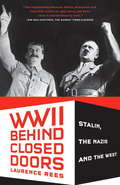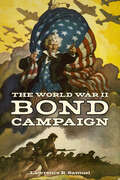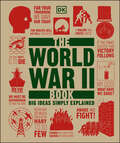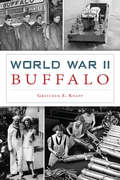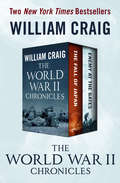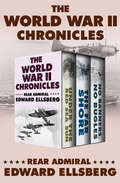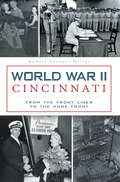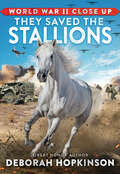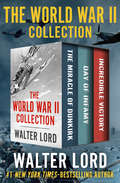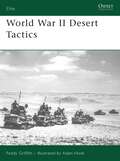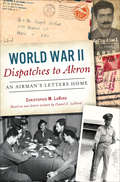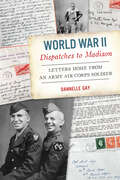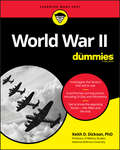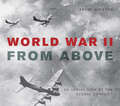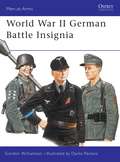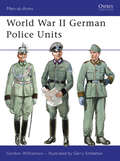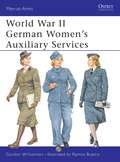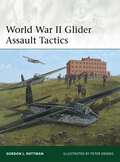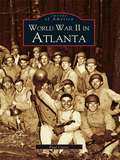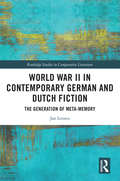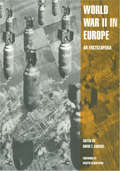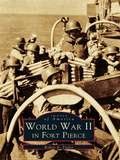- Table View
- List View
World War II Behind Closed Doors: Stalin, the Nazis and the West
by Laurence ReesIn this revelatory chronicle of World War II, Laurence Rees, winner of the 2006 British Book Award for History, documents the dramatic and secret deals that helped make the war possible and prompted some of the most crucial decisions made during the conflict. Drawing on material available only since opening of archives in Eastern Europe and Russia, Rees re-examines the key choices made by Stalin, Churchill and Roosevelt during the war. And as the truth about Stalin's earlier friendly relationship with the Nazis is laid bare, a devastating and surprising picture of the Soviet leader emerges. The emotional core of the book is the amazing new testimony obtained from nearly a hundred separate witnesses from the period--former Soviet secret policemen, Allied seamen who braved Arctic convoys and Red Army veterans who engaged Germans in hand-to-hand fighting on the Eastern Front. Their dramatic personal experiences make clear in a compelling and fresh way the reasons why the people of Poland, the Baltic states and other European countries simply swapped the rule of one tyrant for another. Rees' ability to weave high politics--the meeting of the Allied leaders at Tehran, Yalta and Potsdam--with the dramatic personal experiences of those on the ground who bore the consequences of their decisions is eye opening. World War II Behind Closed Doors will change the way we think about the Second World War.
The World War II Bond Campaign (World War II: The Global, Human, and Ethical Dimension)
by Lawrence R. SamuelHow America’s greatest marketing triumph in World War II shaped race, ethnicity, and class in modern AmericaThe World War II Bond Campaign is a history of the World War II bond drive led by the federal government, an effort called the most successful marketing operation in history. By the war’s end, some 85 million Americans had spent $186 billion in an unprecedented outpouring of patriotism that contributed to the military victory and the prosperity of the following decades. The FDR administration used bonds to raise capital to support the war and promote national unity within the context of the nation’s increasingly pluralistic society as the “melting pot” theory was retired. African Americans, Euro-Americans, and labor union members enthusiastically bought bonds to express national loyalty but also to demonstrate racial, ethnic, or class pride, a reflection of their dualistic or “hyphenated” identities.Drawing on various primary sources, The World War II Bond Campaign illustrates how the Treasury Department’s multicultural marketing strategies tapped into Americans’ aspirations alongside their patriotic impulses. Citizens of all social and economic backgrounds eagerly responded to what can be seen as the selling of America, making the subject an ideal lens to view national identity at a critical moment in the country’s history. The author contends that the drive’s success helped pave the way for the emergence of both the civil rights movement and the vigorous consumer culture of the postwar years.
The World War II Book (DK Big Ideas)
by DKLearn about the rise of Adolf Hitler, Pearl Harbour and the D-Day Landings in The WWII Book.Part of the fascinating Big Ideas series, this book tackles tricky topics and themes in a simple and easy to follow format. Learn about World War 2 in this overview guide to the subject, great for beginners looking to learn and war experts wishing to refresh their knowledge alike! The WWII Book brings a fresh and vibrant take on the topic through eye-catching graphics and diagrams to immerse yourself in. This captivating book will broaden your understanding of World War 2, with:- More than 100 ground-breaking ideas on the Second World War- Packed with facts, charts, timelines and graphs to help explain core concepts- A visual approach to big subjects with striking illustrations and graphics throughout- Easy to follow text makes topics accessible for people at any level of understandingThe World War II Book is the perfect introduction to the biggest war in history, aimed at adults with an interest in the subject, and politics and history students wanting to gain more of an overview. Here you&’ll discover more than 90 of the key ideas and events during and surrounding the conflict, through exciting text and bold graphics. If you&’ve ever wanted to know the crucial events of World War 2 and the people behind them, this is the perfect book for you.Your World War 2 Questions, Simply ExplainedDiscover the key battles, tactics, technologies and turning points of the Second World War – the epic conflict that shaped the modern world. If you thought it was difficult to learn about the many events and key figures of World War 2, The WWII Book presents vital information in a clear layout. From Fascism in the 1930s to Pearl Harbor, Hitler and Nazi Germany to the bombing of Hiroshima - fantastic mind maps and step-by-step summaries will teach you all the main concepts. The Big Ideas SeriesWith millions of copies sold worldwide, The WWII Book is part of the award-winning Big Ideas series from DK. The series uses striking graphics along with engaging writing, making big topics easy to understand.
World War II Buffalo (Military)
by Gretchen E. KnappWhen President Roosevelt visited Buffalo in November 1940, he found a hardworking city with a large immigrant population manufacturing aircraft for the Allies. Nearby Fort Niagara inducted over 100,000 young men, resulting in an acute labor shortage. American Brass, Bell Aircraft, Chevrolet, Curtiss-Wright, Houde Engineering and Republic Steel reluctantly, then gladly, hired women. More than 300,000 defense workers toiled in hot factories for high wages despite transportation, housing and food shortages. The aircraft plants alone employed 85,000 on forty-eight-hour workweeks. Buffalonians watched the flag raising at Iwo Jima, participated in the Manhattan Project and observed the formal surrender of Japan in Tokyo Bay. Author Gretchen Knapp brings to life the challenges and contributions of daily life during wartime.
The World War II Chronicles: The Fall of Japan and Enemy at the Gates
by William J. CraigA &“virtually faultless&” account of the final weeks of World War II in the Pacific and the definitive history of the battle for Stalingrad together in one volume (The New York Times Book Review). Author William Craig traveled to three different continents, reviewed thousands of documents, and interviewed hundreds of survivors to write these New York Times–bestselling histories, bringing the Eastern Front and the Pacific Theater of World War II to vivid life. The Fall of Japan masterfully recounts the dramatic events that brought an end to the Pacific War and forced a once-mighty nation to surrender unconditionally. From the ferocious fighting on Okinawa to the all-but-impossible mission to drop the second atom bomb, and from Franklin D. Roosevelt&’s White House to the Tokyo bunker where tearful Japanese leaders first told the emperor the war was lost, Craig draws on Japanese and American perspectives to capture the pivotal events of these climactic weeks with spellbinding authority. Enemy at the Gates chronicles the bloodiest battle of the war and the beginning of the end for the Third Reich. On August 5, 1942, giant pillars of dust rose over the Russian steppe, marking the advance of Hitler&’s 6th Army. The Germans were supremely confident; in three years, they had not suffered a single defeat. The siege of Stalingrad lasted five months, one week, and three days. Nearly two million men and women died, and the 6th Army was completely destroyed. The Soviet victory foreshadowed Nazi Germany&’s downfall and the rise of a communist superpower. Heralded by Cornelius Ryan, author of The Longest Day, as &“the best single work on the epic battle of Stalingrad,&” Enemy at the Gates was the inspiration for the 2001 film of the same name, starring Joseph Fiennes and Jude Law.
The World War II Chronicles: Under the Red Sea Sun, The Far Shore, and No Banners, No Bugles
by Rear Admiral Edward EllsbergA navy admiral&’s firsthand accounts of three triumphant operations in Europe and North Africa during World War II. After the attack on Pearl Harbor, naval engineering genius Edward Ellsberg came out of retirement to serve his country once again. In these three riveting histories, he recounts the incredible salvage missions and audacious battle plans he took part in during the Second World War. Under the Red Sea Sun: In 1942, Mussolini&’s forces were on the run in East Africa. At Massawa, Eritrea, the fleeing Italians left the largest mass wreck in the world, turning a vital port into a tangle of shattered ships and dangerous booby traps. In order to continue the war effort and push back the Axis powers in Africa, the Allies enlisted Commander Ellsberg, who navigated the complicated American and British bureaucracies to pull off a historic feat of engineering—the largest of its kind the world had ever seen. The Far Shore: Rear Admiral Ellsberg describes in detail the meticulous preparation and efforts behind the Normandy Invasion—efforts that would keep the flow of men and materials streaming onto the beaches and into the heart of Europe. From dealing with the extremes of engineering possibilities to wrestling with the knowledge that countless lives depended on the success of his intricate planning, Ellsberg worked himself into exhaustion to do his part. Vividly described by a man who saw firsthand the horrors of war and the cost of victory, The Far Shore takes readers through the brutal surf, onto the bloody beaches, and into the mind of one of World War II&’s little-known heroes. No Banners, No Bugles: In Oran, Algeria, a crucial port city, Ellsberg helped the Allies prepare for Operation Torch, the fight to reclaim North Africa from the Axis powers. As General Eisenhower&’s chief of salvage in the Mediterranean, Ellsberg had to sort out the disorganized mess left by the Vichy French and find a way to open the harbor, though his flagging health proved to be a dangerous obstacle. No Banners, No Bugles is the riveting story of how Ellsberg, the miracle worker, tackled his greatest mission yet.
World War II Cincinnati: From the Front Lines to the Home Front (Military)
by Robert Earnest MillerWorld War II transformed Cincinnati from a relatively important but parochial midwestern city into a teeming bastion of military might. While thousands served in the nation's armed forces, others contributed to rationing programs, salvage drives, blackouts and war bond rallies. Scores of community-based programs blossomed as Cincinnatians on the home front threw themselves wholeheartedly into the "total war" that Washington believed necessary for victory. After answering the call to treat domestic duty as seriously as any battleground assignment, the Queen City emerged from the war as utterly changed as the nation itself. Author Robert Miller brings to life this dramatic, patriotic period in Cincinnati's history.
World War II Close Up: They Saved the Stallions
by Deborah HopkinsonAward-winning author Deborah Hopkinson deftly brings to life the thrilling true story of the desperate fight to save the world-famous Spanish Riding School in Vienna and its beloved Lipizzaner horses during World War II, perfect for fans of I Survived!Scholastic Focus is the premier home of thoroughly researched, beautifully written, and thoughtfully designed works of narrative nonfiction aimed at middle grade and young adult readers. These books help readers learn about the world in which they live and develop their critical thinking skills so that they may become dynamic citizens who are able to analyze and understand our past, participate in essential discussions about our present, and work to grow and build our future.In the closing months of World War II, American bombs rained down on Nazi Germany and its territories, including Austria.As glass shattered around them in Vienna, an ordinary-looking horse named Nero and his stable mates, the dancing white Lipizzaner stallions of the famed Spanish Riding School, quiver and shake in fear. But they do not panic. Somehow, they sense the school's director, dedicated horseman Alois Podhajsky, will do everything he can to keep them safe.Yet Alois can't do it alone. And in the chaotic last days of the war, as their fate becomes more uncertain than ever, Nero will play a key role in helping Alois appeal for aid from an unlikely ally -- America.But time is running out. It will take a daring band of American soldiers -- along with horse lovers from opposing sides -- to pull off a secret mission to save the Lipizzaners from certain destruction. United by their love of horses, these unsung heroes risked their lives to preserve the majesty of this rare breed for generations to come.Join the ride as critically acclaimed author Deborah Hopkinson brings to life the exhilarating true story of Operation Cowboy and the miraculous survival of the Spanish Riding School. Featuring rare family photos and told for the first time for young readers, They Saved the Stallions is bound to please every history fan and horse lover.
The World War II Collection: The Miracle of Dunkirk, Day of Infamy, and Incredible Victory
by Walter LordFull-length accounts of three decisive WWII events—Pearl Harbor, Midway, and the evacuation of Dunkirk—from a #1 New York Times–bestselling author. In May 1940, the remnants of the French and British armies, broken by Hitler&’s blitzkrieg, retreated to the beach at Dunkirk. Prime Minister Winston Churchill ordered an evacuation on May 26, expecting to save no more than a handful of his men. But Britain would not let its soldiers down. Hundreds of fishing boats, pleasure yachts, and commercial vessels streamed into the Channel to back up the Royal Navy. The Miracle of Dunkirk is a striking history of a week when the fate of Britain—and the World—hung in the balance. On the morning of June 4, 1942, doom sailed on Midway. Hoping to put itself within striking distance of Hawaii and California, the Japanese navy planned an ambush that would obliterate the remnants of the American Pacific fleet. On paper, the Americans had no chance of winning. But because their code breakers knew what was coming, the American navy was able to prepare an ambush of its own. In Incredible Victory, Walter Lord recounts two days of savage battle, during which a small American fleet defied the odds and turned the tide of World War II. December 7, 1941, began as a quiet morning on the American naval base at Pearl Harbor. But as Japan&’s deadly torpedoes suddenly rained down on the Pacific fleet, soldiers, generals, and civilians alike felt shock, then fear, and then rage. From the chaos, a thousand personal stories of courage emerged. Drawn from hundreds of interviews, letters, and diaries, Walter Lord&’s Day of Infamy recounts the many tales of heroism and tragedy of those who experienced the attack firsthand. These three acclaimed war chronicles showcase Walter Lord at the top of his game as a narrative nonfiction master.
World War II Desert Tactics
by Adam Hook Paddy GriffithOsprey's study of desert tactics employed in North Africa during World War II (1939-1945). In 1940-43 North Africa saw the first major desert campaign by modern mechanized armies. The British, Italians, German Afrika Korps and US Army all addressed and learned from the special problems - human, logistical, mechanical and tactical - of the desert environment, most significantly a terrain empty of resources and offering little chance of concealment. Paddy Griffith traces the fast-learning development of armor, artillery and infantry tactics in this exceptional situation and illustrates it using references to the major engagements in the North African theater, which involved some of the greatest tacticians of World War II in one of the pivotal arenas.
World War II Dispatches to Akron: An Airman's Letters Home
by Christopher LaHurdA bombardier’s story of serving in the skies over Europe—and surviving in a POW camp—as told through his correspondence with his Ohio family.On his twenty-sixth horrifying mission over the hostile skies of Nazi Europe, a charismatic bombardier, seated at the nose of a B-17, strapped on his parachute as his disintegrating bomber dropped uncontrollably to the ground. What got him to this point, the ensuing months behind barbed wire, and his daily letters written to his family in Akron, Ohio, makes for an emotionally intense memoir. This is the true account of a single individual who represents the countless unsung warriors of the greatest generation during World War II.Previously published as A Story of One
World War II Dispatches to Madison: Letters Home from an Army Air Corps Soldier (Military)
by Dannelle GayAmidst the chaos and uncertainty of World War II, one soldier found solace and strength in letters from home. An Army Air Corps serviceman from a prominent Madison family, Bob Gay paints a vivid picture of a young man's journey through a tumultuous era, revealing the profound love he held for his family. As Gay fulfills his duty on the frontlines, his mother's unwavering support shines through her involvement with the Red Cross, while his father's dedication as a ration board member and air raid warden mirrors a nation's collective sacrifice. World War II Dispatches to Madison is a tribute to a humble and kind soul who never sought the spotlight. In honor of her ancestor Robert Gay, Dannelle's book will benefit the Wounded Warrior Project.
World War II For Dummies (For Dummies Ser.)
by Keith D. DicksonInvestigate the factors that led to war Examine key turning points, including D-Day and Hiroshima Get to know the opposing forces — the Allies and the Axis Explore the greatest war in history World War II was the most destructive conflict of the 20th century. How did it happen — and why? Packed with fascinating anecdotes, interesting sidebars, and top ten lists, this friendly reference contains everything you need to know about World War II, from the issues that caused the war to its most crucial confrontations and what happened in the aftermath. Read about important figures on both sides, study Hitler's war against the Jews, and find out how the Allies finally achieved victory. Whatever your interest, World War II For Dummies is your go-to guide. Inside … The significance of World War II Hitler's rise to power The invasion of Eastern Europe Pearl Harbor and U.S. neutrality Life and labor on the home front The Holocaust Liberation and what came next
World War II for Kids: A History with 21 Activities (For Kids series)
by Senator John Mccain Richard PanchykNow more than ever, kids want to know about our country's great struggles during World War II. This book is packed with information that kids will find fascinating, from Hitler's rise to power in 1933 to the surrender of the Japanese in 1945. Much more than an ordinary history book, it is filled with excerpts from actual wartime letters written to and by American and German troops, personal anecdotes from people who lived through the war in the United States, Germany, Britain, Russia, Hungary, and Japan, and gripping stories from Holocaust survivors--all add a humanizing global perspective to the war. This collection of 21 activities shows kids how it felt to live through this monumental period in history. They will play a rationing game or try the butter extender recipe to understand the everyday sacrifices made by wartime families. They will try their hands at military strategy in coastal defense, break a code, and play a latitude and longitude tracking game. Whether growing a victory garden or staging an adventure radio program, kids will appreciate the hardships and joys experienced on the home front.
World War II From Above: An Aerial View of the Global Conflict
by Jeremy HarwoodThis pictorial military history examines the use of spy planes by both sides of WWII as they battled to gain advantage through aerial intelligence.In World War II From Above, Jeremy Harwood examines a little-known aspect of intelligence gathering operations as they evolved throughout the conflict. The volume features dozens of eye-catching aerial reconnaissance photographs drawn from the archives compiled by all the major fighting powers. His accompanying text profiles the daring pilots who took these photographs and the photographic interpreters who pioneered a new science to reveal the secrets they contained.This inspiring and informative history focuses on crucial operations from both the Allied and Axis perspectives—from the American Doolittle Raid against Japan to the numerous Allied battles against Germany’s cutting-edge U-boats to the Battle of Monte Cassino and a score of other epic campaigns.Told through photographs that have largely never before appeared in print outside of their reconnaissance origins, World War II From Above combines history with photography, placing the reader in the midst of the action.
World War II German Battle Insignia
by Darko Pavlovic Gordon WilliamsonThe remarkable war effort of the German armed forces on three fronts between 1939 and 1945 was recognised by a wider range of insignia than seen in the Allied armies. While the Wehrmacht displayed fewer unit insignia than the Allies, a glance at a German soldier's tunic could reveal much more about his actual combat experience. In this book an experienced researcher explains and illustrates the Battle and Assault Badges of the Army, Waffen-SS and Luftwaffe ground troops of World War II; the sleeve shields and cuffbands issued to mark service in particular campaigns; wound badges, commemorative medals, and other types of insignia.
World War II German Police Units
by Gordon Williamson Gerry EmbletonThe wartime Police were headed by Himmler as chief of the SS; and throughout the occupied nations the regional SS commanders were specifically termed 'Higher SS and Police Leaders'. Hitler's police was not a single service, but a vast machinery which included many special categories ranging from conventional criminal detectives, and municipal and rural police to combat battalions sent to Russia, and from border and customs police to special railway and waterway departments, fire brigades and emergency engineer squads, and even a colonial service for North Africa. The author explains the origins, the complex organization and the particular duties of the many different police branches that formed such a critical part of the Nazi apparatus and ensured that control was maintained inside Hitler's Fortress Europe. His painstaking research has unearthed fascinating new information about the German police services and their many different uniforms and insignia, which are recreated in the meticulously detailed color artwork.From the Trade Paperback edition.
World War II German Womens Auxiliary Services
by Ramiro Bujeiro Gordon WilliamsonUnder the Nazi regime, Hitler's conservative views on the place of housewives and mothers in society limited German women to a much less active role in World War II (1939-1945) than their British and Allied counterparts. Nevertheless, the demands of a prolonged war did see German women in a range of uniforms as auxiliaries with the Army, Navy, Air Force and SS, particularly in the signals and air defence services. This unique book explains and illustrates these organisations and their uniforms and insignia, as well as Red Cross nurses, and auxiliaries of the Labour Corps, Customs Service, National Socialist Women's Organisation, and League of German Maidens (Hitler Youth).
World War II Glider Assault Tactics
by Peter Dennis Gordon RottmanFrom Eben Emael to Crete, Sicily, Market Garden, the Rhine, and Burma, glider-borne paratroopers brought extra firepower to bear using techniques that helicopter troops adapted for modern air cavalry techniques.This book explains the development and organization of World War II glider troops, their mounts, and the air squadrons formed to tow them; the steep and costly learning-curve, as armies and air forces worked out the techniques needed to carry and deliver men and equipment safely to the chosen landing zones; and the tactics that such troops learned to employ once they arrived on the battlefield. All these aspects are illustrated by reference to famous operations, including the German assault on Crete (1941), the Allied assault on Sicily (1943), the Allied Normandy landings and Operation Market Garden (1944), the Rhine crossings (1945), and also the Allied operations in Burma to insert and resupply the "Chindits" behind Japanese lines (1944).The major weakness of the military paratrooper is the limited load of kit that he can carry during the jump, making his combat endurance short unless he is quickly re-supplied. Military gliders came of age in World War II, when glider-assault infantry were the forerunners of today's helicopter-delivered airmobile troops. From the light pre-war sports and training machines, several nations developed troop-carrying gliders capable of getting a whole squad or more of infantry, with heavy weapons, onto the ground quickly, with the equipment that paratroopers simply could not carry. Gliders were also developed to carry light artillery, antitank guns, jeeps, and even special lightweight tanks. They made up at least one-third of the strength of US, British, and German airborne divisions in major battles, and they also carried out several daring coup de main raids and spearhead operations. However, the dangers were extreme, the techniques were difficult, the losses were heavy (particularly during night operations), and the day of the glider assault was relatively brief.
World War II Heroes: Ten True Tales
by Allan ZulloThis is a good book about 10 different men who fought in the War. Each man earned the Congressional Medal of Honor.
World War II Historical Reenactment in Poland: The Practice of Authenticity (Routledge Studies in Second World War History)
by Kamila Baraniecka-OlszewskaThis book explores the consequences of the latest political shifts in Central Eastern Europe: the rise of right-wing parties and, among other things, politics becoming more invested in history. These phenomena coincide and overlap with the democratisation of history by turning the past into a hot topic, persistently present in the public sphere and often evoking strong emotions. Ethnographic research (conducted in 2012-2016) focusing on how World War II reenactors experience the past serves as the basis to analyse the ways in which the group uses the widespread, often institutionalised interest in history to – on the one hand – become involved in debates on World War II and the remembrance thereof, and – on the other – to authentically experience this past. The volume therefore analyses how physical the process of creating and experiencing grassroots visions of the past is, and how these visions interact with the public discourse about the past. Reenactors’ ability to marry the often-contradictory orders of historical truth, authenticity, and representation is explored. Moreover, Baraniecka-Olszewska analyses how the reenactors overcome various obstacles on their way towards authentic experiences, performing history through their bodies.
World War II in Atlanta (Images of America)
by Paul CraterFew historical events shaped the city of Atlanta more than World War II. A hub for the Civil Rights movement in the 1950s and 1960s, Atlanta is now home to over four million people and serves as national headquarters for a dozen Fortune 500 companies. It would never have developed to such prominence, however, without the Allied victory in the global conflict. From the social reforms of the New Deal to the economic impact of war industries, to the early gains of the Civil Rights movement, World War II in Atlanta illustrates the transformation of the city from a regional Southern town into a major industrial metropolis. Through images selected from the collections of the Kenan Research Center at the Atlanta History Center, this volume examines the war's role in creating today's vibrant, sprawling megalopolis with its diverse population. View photographs of wartime president Franklin D. Roosevelt during his visits to Atlanta and other Georgia cities. Pictures from the homefront include war bond advertisements, Bob Hope at a USO show, and victory garden promotions. The two warships named Atlanta as well as the Liberty ships named for famous Atlantans illustrate the symbolic connections between the city and the war. In addition, portraits and personal stories of some of Atlanta's sons and daughters who served in the war highlight the human side of the conflict.
World War II in Contemporary German and Dutch Fiction: The Generation of Meta-Memory (Routledge Studies in Comparative Literature)
by Jan LensenWorld War II in Contemporary German and Dutch Fiction: The Generation of Meta-Memory offers a comparative study of the construction of World War II memory in contemporary German, Flemish, and Dutch literature. More specifically, it investigates in what ways the large temporal distance to the historical events has impacted how literary writers from these three literatures have negotiated its meaning and form during the last decades. To that end, this book offers analyses of nine novels that demonstrate a pronounced reflexivity on the conditions of contemporary remembering. Rather than a dig for historical truth or a struggle with historical trauma, these novels reflect on the transmission, the narrative shapes, the formation processes, and the functions of World War II memory today, while asserting a self-conscious and often irreverent approach toward established mnemonic routines, practices, and rules. As the analyses show, this approach is equally articulated through the novels’ poetics, which are marked by a large formal diversity and a playfulness that highlights mnemonic agency, a posttraumatic positioning, and the ascendency of the literary over the historiographical. Based on these findings, this book proposes the emergence of a new paradigm within the postwar cultural assessment of World War II: the generation of meta-memory.
World War II in Europe: An Encyclopedia (Military History of the United States)
by David T. Zabecki Carl O. Schuster Paul J. Rose William H. Van HusenFirst Published in 1999. Routledge is an imprint of Taylor & Francis, an informa company.
World War II in Fort Pierce (Images of America)
by Robert A. TaylorFew Florida communities felt the impact of World War II as much as the Atlantic-coast town of Fort Pierce. With a population that soared along with its economy, the small city made an important contribution to Allied victory by hosting a major military training base. Prior to that, the war had come only as close as the German submarines stalking targets off the southern coast of the peninsula. In 1943, however, the U.S. Navy commissioned its newestamphibious training base in Fort Pierce, and tens of thousands of young men would eventually prepare for combat on the town's sunny shores. The intensive physical and mental training was hardly "a day at the beach," and within a few months, Fort Pierce had become a major military post with a national reputation. It also became the training site of some of the most elite units of the armed forces, including the Scouts and Raiders, U.S. Army Rangers, and the legendary "frogmen."
